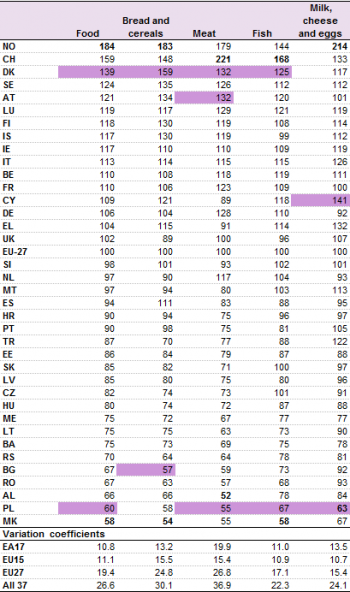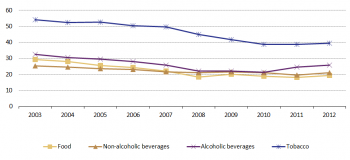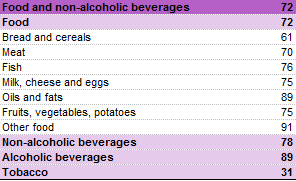Archive:Comparative price levels for food, beverages and tobacco - data 2012
Significant differences in price levels for food, beverages and tobacco across Europe in 2012
Statistics in focus 15/2013; Author: Barbara KURKOWIAK
ISSN:2314-9647 Catalogue number:KS-SF-13-015-EN-N
This Statistics Explained article is outdated and has been archived - for recent articles on this topic see here.

Source: Eurostat (prc_ppp_ind)
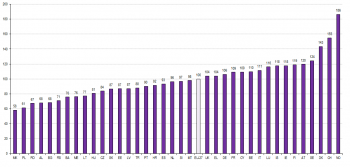
Source: Eurostat (prc_ppp_ind)
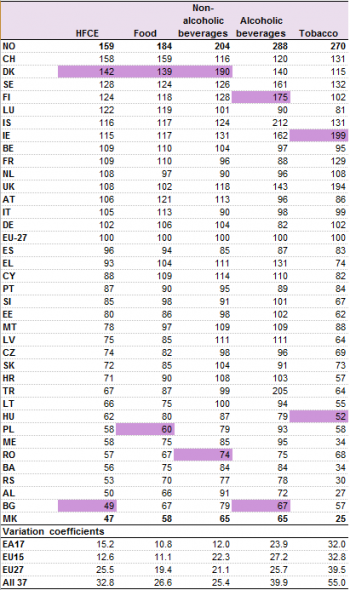
Source: Eurostat (prc_ppp_ind)

Source: Eurostat (prc_ppp_ind)
This article focuses primarily on price levels for food, beverages and tobacco in 37 European countries. The country groups included in the analysis are the 27 European Union (EU) Member States, 3 EFTA countries (Iceland, Norway and Switzerland), acceding country Croatia, 4 candidate countries (the former Yugoslav Republic of Macedonia, Montenegro, Serbia and Turkey), and 2 potential candidate countries (Albania, Bosnia and Herzegovina).
Main statistical findings
Price levels for food, beverages and tobacco vary considerably across the EU Member States. In 2012, the prices for food and non-alcoholic beverages in Denmark were 143 % of the EU average, while in Poland they were 61 % of the EU average. Alcohol was priced in Finland at 175 % of the EU average, but at 67 % in Bulgaria. For tobacco the highest prices were observed in Ireland (199% of the EU average), while the lowest were recorded in Hungary (52%).
These are some of the findings of Eurostat's most recent survey on food, beverages and tobacco prices, carried out in 2012 within the Eurostat-OECD Purchasing Power Parities (PPP) Programme. The survey covered a total of approximately 500 comparable products, enabling all countries to price a sufficient number of products representative of their consumption pattern.
The results of the survey are expressed in price level indices (PLIs), which provide a comparison of countries' price levels with respect to the European Union average: if the price level index is higher than 100, the country concerned is relatively expensive compared to the EU average, while on the other hand, if the price level index is lower than 100, then the country is relatively inexpensive compared to the EU average. Map 1 and Figure 1 show the 2012 PLIs for food and non-alcoholic beverages, while the tables present PLIs for sub-groups of products.
Food, beverages and tobacco
Table 1 shows the PLIs for four important groups: food, non-alcoholic beverages, alcoholic beverages and tobacco. These groups represent on average 16%, 2%, 3% and 3% of household expenditure respectively. For reference, the PLIs of total household final consumption expenditure (HFCE) are also presented. The shaded fields indicate the highest and lowest PLIs per product group among the 27 EU Member States. The highest and lowest PLIs among all 37 participating countries are marked in bold. At the bottom of the table, variation coefficients are provided for the euro area (EA-17), EU-15 (EU-15), the present EU-27 (EU-27) and the group of all countries participating in the program (All 37). The variation coefficient is defined as the standard deviation of the PLIs of the respective group of countries as a percentage of their average PLI.
The higher the variation coefficient, the higher is the price dispersion in the respective product group. Norway is the most expensive country for food, non-alcoholic and alcoholic beverages and tobacco within the group of 37 participating countries. Amongst the Member States, Denmark is the most expensive country for food and non-alcoholic beverages. Finland has the highest price level for alcoholic beverages in the EU, while Ireland is by far the most expensive for tobacco. The former Yugoslav Republic of Macedonia is the least expensive country of all 37 in all four product groups. Among the EU Member States, the lowest prices for food are observed in Poland, for alcoholic beverages in Bulgaria, for non-alcoholic beverages in Romania and for tobacco in Hungary.
Price dispersion is most pronounced within the 37 country group, including both the high price EFTA countries and the mostly low price Western Balkan countries. Price dispersion is much less pronounced in the euro area than in the EU as a whole. The lowest price dispersion is found for food, and the highest for tobacco, mainly due to large differences in excise taxation on the latter across the 37 countries.
Bread and cereals, meat, fish and dairy products
The results of the survey also provide an insight into the different sub-groups of products for all participating countries. Table 2 presents the PLIs for bread and cereals, meat, fish and dairy products. These groups represent on average 17 %, 25%, 3 % and 19 % of household expenditure on food respectively. For comparison this table includes the PLIs for food as a whole.
Amongst all 37 countries Switzerland shows the highest price levels for meat and fish, while Norway has the highest PLIs for dairy products and for bread and cereals. Within the EU Denmark is the most expensive country for meat (together with Austria), fish, bread and cereals, whilst Cyprus is the most expensive for milk, cheese and eggs.
The former Yugoslav Republic of Macedonia is the cheapest country for bread and cereals and fish, while Albania has the lowest PLIs for meat. Among the EU Member States, the lowest price level for almost all sub-categories is observed in Poland, except for bread and cereals which are least expensive in Bulgaria.
The level of dispersion of prices is rather similar between these four product groups. Meat shows the highest price dispersion in most country groups. Within the EU, the lowest price dispersion is found for dairy products.
Oils and fats, fruits, vegetables, potatoes and other food products
Table 3 shows the PLIs for three further groups of food products: oils and fats; fruits, vegetables and potatoes as well as other food products. These groups represent on average 5 %, 20 % and 12 % of household expenditure for food respectively.
Among all 37 countries the lowest prices for all categories can again be observed in the former Yugoslav Republic of Macedonia, while the highest prices are found in Norway. Among the EU Member States, Poland is the most inexpensive country for all sub-categories. Denmark is the most expensive EU country for all products except for fruits, vegetables and potatoes for which the highest prices are observed in Sweden.
Within these 3 categories, the highest price dispersion can be observed for fruits, vegetables and potatoes.
Price convergence
A comparison of the price dispersion within the EU observed on the basis of the surveys conducted since 2003 shows that for each main group of products prices have converged.
Figure 2 shows the development of the variation coefficient of the PLI for the various categories. A decrease of the variation coefficient for the Member States between 2003 and 2012 can be seen as price convergence for the respective product group. Price differences have decreased most for food and tobacco and least for non-alcoholic beverages. While until 2008 the convergence was quite pronounced, since 2008 convergence has slowed and even reversed for some categories.
Price level indices for Kosovo
In 2012, in the framework of a pilot project, the Statistical Office of Kosovo[1] participated in the Eurostat-OECD Purchasing Power Parities Programme by carrying out the price survey on food, beverages and tobacco.
Table 4 shows the PLIs as they result from the survey. Price levels in Kosovo are at a similar level to those in Serbia, Montenegro and Bosnia and Herzegovina.
The impact of exchange rate changes on PLIs
PLI for a given country is calculated as its purchasing power parity (PPP) divided by its annual average exchange rate to the euro. This implies that exchange rate movements have an impact on the PLIs. A depreciation of a country's currency against the euro will make the country cheaper in comparison to euro area countries and this will show as a decrease of the relative price level expressed in the PLI. Between 2009 and 2012, several countries experienced relatively large exchange rate movements. The most prominent examples are Serbia (depreciation of 20.4% between 2009 and 2012) and Switzerland (appreciation of 20.2%). The national currencies of Sweden and Norway also appreciated against the euro by 18.0% and 14.4% respectively. This explains in part some changes in the position of countries in PLIs compared to previously published data for 2009.
Definition of the product groups
The product groups presented in the article include the following types of products:
- bread and cereals: rice, other cereals, flour and other cereal products, bread, other bakery products, pasta products;
- meat: beef and veal, pork, lamb, mutton and goat, poultry, other meats and edible offal, delicatessen and other meat preparations;
- fish: fresh, chilled or frozen fish and seafood, preserved or processed fish and seafood;
- milk, cheese, eggs: fresh milk, preserved milk and other milk products, cheese, eggs and egg-based products;
- oils and fats: butter, margarine, other edible oils and fats;
- fruits, vegetables, potatoes: fresh or chilled fruit, frozen, preserved or processed fruit and fruit-based products, fresh or chilled potatoes, frozen, preserved or processed vegetables and vegetable-based products;
- other food products: sugar, jams, marmalades and honey, confectionery, chocolate and other cocoa preparations, edible ice, ice cream and sorbet, food products n.e.c.;
- non-alcoholic beverages: coffee, tea and cocoa, mineral waters, soft drinks and concentrates, fruit and vegetable juices;
- alcoholic beverages: spirits, wine, beer;
- tobacco: tobacco and narcotics.
Data sources and availability
The data in this article are produced by the Eurostat-OECD Purchasing Power Parity (PPP) programme. The full methodology used in the programme is described in the Eurostat-OECD Methodological manual on purchasing power parities.
Purchasing power parities (PPP)
Purchasing power parities (PPPs) are price relatives that show the ratio of the prices in national currencies of the same good or service in different countries. For example, if the price of a hamburger in France is EUR 2.84 and in the United Kingdom it is GBP 2.20, the PPP for hamburgers between France and the United Kingdom is EUR 2.84 to GBP 2.20, or EUR 1.29 to the pound. In other words, for every pound spent on hamburgers in the United Kingdom, EUR 1.29 would have to be spent in France in order to obtain the same quantity and quality – or volume – of hamburgers.
Published PPPs, usually refer to product groups or broad aggregates like gross domestic product (GDP) rather than to individual products. However, these aggregate PPPs are based on sample surveys of individual goods and services.
Price level indices (PLI)
The results of the survey are expressed in the form of price level indices (PLIs). PLIs are the ratios of PPPs to exchange rates. They provide a comparison of countries' price levels relative to the European Union average: if the price level index is higher than 100, the country concerned is relatively expensive compared to the EU average and vice versa, while if the price level index is lower than 100, then the country is relatively cheap compared to the EU average. The EU average is calculated as the weighted average of the national PLIs, weighted with the expenditures corrected for price level differences.
Price level indices are not intended to rank countries strictly. In fact, they only provide an indication of the order of magnitude of the price level in one country in relation to others, particularly when countries are clustered around a very narrow range of outcomes. The degree of uncertainty associated with the basic price data and the methods used for compiling PPPs, may affect in such a case the minor differences between the PLIs and result in differences in ranking which are not statistically or economically significant.
Organisation
Within the framework of the Eurostat-OECD Purchasing Power Parities (PPP) programme, surveys on prices of household goods and services are carried out cyclically by the National Statistical Institutes (NSIs) of 37 countries. Each survey cycle comprises 6 surveys, each related to a particular group of household consumption products. As 2 surveys are run per year, the whole survey cycle takes 3 years to conclude, before the next cycle starts. The prices used for this publication were collected in spring 2012 and extrapolated to annual average prices for 2012 using detailed consumer price indices. The PLIs presented in this article are based on annual national average prices for about 500 goods in total. The expenditure shares reported in this article are based on national accounts data for 2011 and represent the average over all participating countries. The national accounts data are also used as weights in the aggregation of detailed PLIs to aggregate PLIs such as for household final consumption expenditure (HFCE).
Context
Purchasing power parities (PPPs) are indicators of price level differences across countries. PPPs tell us how many currency units a given quantity of goods and services costs in different countries. PPPs can thus be used as currency conversion rates to convert expenditures expressed in national currencies into an artificial common currency, the purchasing power standard, eliminating the effect of price level differences across countries.
The main use of PPPs is to convert national accounts aggregates, like the gross domestic product (GDP) of different countries, into comparable volume aggregates. Applying nominal exchange rates in this process would overestimate the GDP of countries with high price levels relative to countries with low price levels. The use of PPPs ensures that the GDP of all countries is valued at a uniform price level and thus reflects only differences in the actual volume of the economy.
PPPs are also applied in analyses of relative price levels across countries. For this purpose, the PPPs are divided by the current nominal exchange rate to obtain a price level index (PLI) which expresses the price level of a given country relative to another, or relative to a group of countries like the EU.
The common rules for the provision of input data, and for the calculation and dissemination of PPPs, are laid down in Regulation 1445/2007 of 11 December 2007.
See also
- Consumer prices - detailed average prices
- Purchasing power parities as example of international statistical cooperation
Further Eurostat information
Main tables
- Main tables (middle column)
- GDP per capita in Purchasing Power Standards (PPS)
- Comparative price levels
- Price convergence between EU Member States
Database
- Purchasing power parities (prc_ppp)
- Purchasing power parities (PPPs), price level indices and real expenditures for ESA95 aggregates (prc_ppp_ind)
- Price convergence indicator (coefficient of variation of comparative price level index for final household consumption in %) (prc_ppp_conv)
Dedicated section
Methodology / Metadata
- Eurostat-OECD Methodological manual on purchasing power parities
- Product list 2010-2012
- Purchasing power parities (ESMS metadata file — prc_ppp_esms)
Other information
- Harmonized Indices of Consumer Prices (HICP)
- Regulation 1445/2007 of 11 December 2007 establishing common rules for the provision of basic information on Purchasing Power Parities and for their calculation and dissemination
External links
- OECD - Purchasing Power Parities (PPP) Statistics
- World Bank - International Comparison Programme (ICP)
Notes
- ↑ This designation is without prejudice to positions on status, and is in line with UNSCR 1244 and the ICJ Opinion on the Kosovo Declaration of Independence.
